The Lenovo ThinkStation P900 Workstation Review: Design 101
by Ian Cutress on May 6, 2015 7:00 AM ESTProfessional Performance: Linux
Linux-Bench: link
Built around several freely available benchmarks for Linux, Linux-Bench is a project spearheaded by Patrick at ServeTheHome to streamline about a dozen of these tests in a single neat package run via a set of three commands using an Ubuntu 11.04 LiveCD. These tests include fluid dynamics used by NASA, ray-tracing, OpenSSL, molecular modeling, and a scalable data structure server for web deployments. We run Linux-Bench and have chosen to report a select few of the tests that rely on CPU and DRAM speed.
C-Ray: link
C-Ray is a simple ray-tracing program that focuses almost exclusively on processor performance rather than DRAM access. The test in Linux-Bench renders a heavy complex scene offering a large scalable scenario.
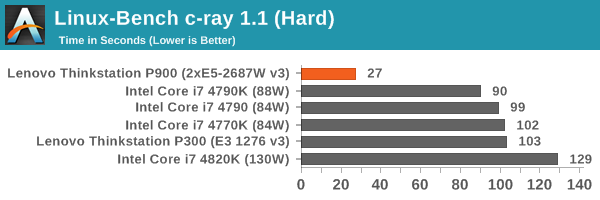
C-Ray doesn't have to deal with inter-CPU transfers or DRAM snooping, resulting in a good score.
NAMD, Scalable Molecular Dynamics: link
Developed by the Theoretical and Computational Biophysics Group at the University of Illinois at Urbana-Champaign, NAMD is a set of parallel molecular dynamics codes for extreme parallelization up to and beyond 200,000 cores. The reference paper detailing NAMD has over 4000 citations, and our testing runs a small simulation where the calculation steps per unit time is the output vector.
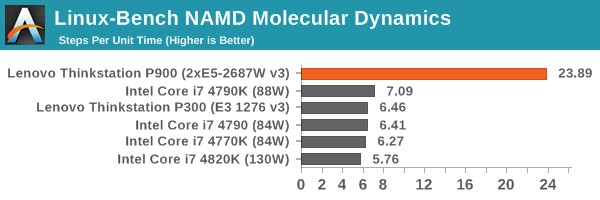
The NAMD libraries are designed to minimise any cross-CPU talking in order to extract performance out of an Intel system. As a result, we get a great result.
NPB, Fluid Dynamics: link
Aside from LINPACK, there are many other ways to benchmark supercomputers in terms of how effective they are for various types of mathematical processes. The NAS Parallel Benchmarks (NPB) are a set of small programs originally designed for NASA to test their supercomputers in terms of fluid dynamics simulations, useful for airflow reactions and design.
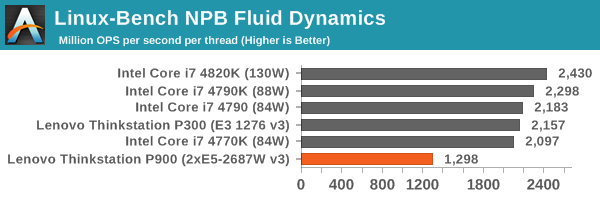
NPB gives a rather low score, based on millions of operations per second and per thread. As a result, a 40 thread system would easily outperform here, but the results are an indication of efficiency per thread.
Redis: link
Many of the online applications rely on key-value caches and data structure servers to operate. Redis is an open-source, scalable web technology with a b developer base, but also relies heavily on memory bandwidth as well as CPU performance.
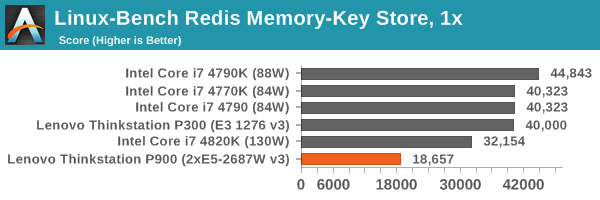
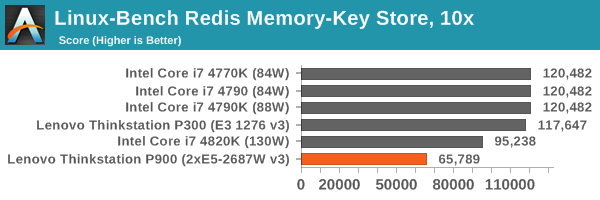

Redis prefers single socket systems almost exclusively, and as a result despite having DDR4-2133 in the P900, the cross-talking for the database takes a hit in the result.










61 Comments
View All Comments
Mikemk - Wednesday, May 6, 2015 - link
"these are the high TDP 160W models with 12 cores"Really? 12 cores?
mapesdhs - Wednesday, May 6, 2015 - link
Indeed, it should say 10, which is ironic as it's correctly described in the spec list that follows.My biggest complaint with systems like these is the lack of any backup drive of some kind for the C-drive; IMO this should be standard on all pro systems by now. I've helped with so many pro users over the years who've had normal rust spinners fail, at least with those there's usually a chance to rescue data before a drive completely dies, but with SSDs, normally no chance.
IBM could at least include a simple MX100 or something for C-drive backup.
Ian.
mapesdhs - Wednesday, May 6, 2015 - link
Also, which C-ray test are you using, with what parameters and how many threads? This matters a lot for comparing systems.mapesdhs - Wednesday, May 6, 2015 - link
Oops, stuck the above in the wrong place, sorry... still no post editing/deletion/etc. yet??dave_the_nerd - Wednesday, May 6, 2015 - link
IBM?MrSpadge - Wednesday, May 6, 2015 - link
IBM can't do anything about this system, it's Lenovo since many years by now.Samus - Wednesday, May 6, 2015 - link
It just goes to show how people still associate IBM with Lenovo's crap :\Let's face facts with facts...quality has declined since IBM turned over their PC division. Most Thinkpads are built to 'Ideapad' quality and engineering now, and in the case of the Thinkpad E, it IS an Ideapad. There isn't anything specifically "wrong" with Ideapads, but they don't live up to the Thinkpad reputation. None of the new Thinkpads do. Lenovo is also notorious for not standing behind their products, EOL'ing products quickly after a successor is released.
The last great Thinkpad's were the T4x/X40 series. Lenovo quickly ruined the T60 series with inadequate cooling for the discrete GPU's, leaving it up to the once-devoted Thinkpad community to create the utility TPfancontrol to fix the fan ramp-up issues. Issues persisted from there, with poor quality lithium cells and poor quality plastic ports ever since. Just Google T400/T500 USB ports cracking.
Long story short, on paper, the new Thinkstation P900 looks great on paper and initial review, but I'm sure issues will creep up that will not be adequately fixed. At least HP and Dell stand behind their products, especially their corporate-class products.
lophiomys - Wednesday, May 13, 2015 - link
FULL ACK to Samus regarding the poor quality of Lenovo Thinkpads and general lack of service by Lenovo. Still typing on a wonderful IBM Thinkpads T43p ...I like the design concept of the P900, but would only consider buying one at a - 50% rebate.
vision33r - Sunday, May 17, 2015 - link
Years ago, when Thinkpad turned over to Lenovo. I said it's gonna suck to my manager and he said it's a "Thinkpad" and he went ahead and purchased about 200 T60 thinkpads. Almost 1/2 of them went back and needed systemboard swaps. The drivers they issued were crap and resulted in lots of blue screens. Today, I don't work on laptops anymore and some poor support person was walking around swapping Thinkpad X1 Carbons. He said they are pretty flakey, a lot of them just crap out and they are brand spanking new. Hardware is great but reliability just not very good.PitneFor - Wednesday, May 6, 2015 - link
wut , backups should be done with backup software to some sort of redundant hard drive array . or plug a usb drive in if your that amateur